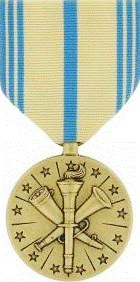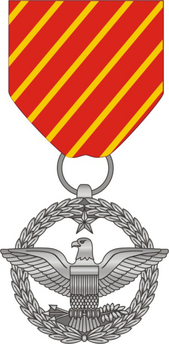The Commendation Medal is a mid-level United States military decoration presented for sustained acts of heroism or meritorious service. Each branch of the United States Armed Forces issues its own version of the Commendation Medal, with a fifth version existing for acts of joint military service performed under the Department of Defense.

The Joint Meritorious Unit Award (JMUA) is a US military award that was established on June 4, 1981, by Secretary of Defense Caspar Weinberger and was implemented by Department of Defense Directive 1348.27 dated July 22, 1982. The Joint Meritorious Unit Award was made retroactive to January 23, 1979.
The Achievement Medal is a military decoration of the United States Armed Forces. The Achievement Medal was first proposed as a means to recognize outstanding achievement or meritorious service of military personnel who were not eligible to receive the higher Commendation Medal or the Meritorious Service Medal.
The Antarctica Service Medal (ASM) was established by the United States Congress on July 7, 1960, under Public Law 600 of the 86th Congress. The medal was intended as a military award to replace several commemorative awards which had been issued for previous Antarctica expeditions from 1928 to 1941. With the creation of the Antarctica Service Medal, the following commemorative medals were declared obsolete;
The Air Force Training Ribbon is the lowest military award of the United States Air Force, ranking only above foreign military awards.

The Humanitarian Service Medal (HSM) is a military service medal of the United States Armed Forces which was created on January 19, 1977 by President Gerald Ford under Executive Order 11965. The medal may be awarded to any member of the United States military who distinguishes himself or herself by meritorious participation in specified military acts or operations of a humanitarian nature.

The Aerial Achievement Medal (AAM) is a decoration of the United States Air Force which was established in 1988. The decoration is intended to recognize the contributions of aircrew members who would, otherwise, not be qualified for the award of the Air Medal.
A Noncommissioned Officer Professional Development Ribbon is an award presented by the United States Army and Air Force to recognize those noncommissioned officers who have completed a prescribed leadership course at an NCO training school. The Navy, Marine Corps, and Coast Guard have no equivalent to the Noncommissioned Officer Development Ribbon.
The Air Force Organizational Excellence Award is a unit award of the United States Air Force created by the Secretary of the Air Force on 26 August 1969. The award is presented to Air Force internal organizations that are entities within larger organizations. Examples of eligible organizations are MAJCOM headquarters, Field Operating Agencies, Direct Reporting Units, and other unique unnumbered organizations.
The Air Force Expeditionary Service Ribbon (AFESR) is a military award of the United States Air Force which was first created in June 2003. The ribbon is awarded to any member of the Air Force who completes a standard contingency deployment.
The Air Force Longevity Service Award is a military award of the United States Air Force established by Air Force General Order 60, on 25 November 1957 by General Thomas D. White, Air Force Chief of Staff. The award was primarily created as an air force equivalent to the service stripes used by other branches of the United States military to denote years of military service. The award is retroactive to the establishment of the U.S. Air Force as an independent service in September 1947. The ribbon is also retroactive for any service with the U.S. Army Air Forces, U.S. Army Air Corps, or U.S. Army Air Service prior to the creation of the U.S. Air Force as a separate service as long as the serviceman was on active duty on or after 18 September 1947.

The Afghanistan Campaign Medal (ACM) is a military award of the United States Armed Forces which was created by Executive Order 13363 of President George W. Bush on November 29, 2004, and became available for general distribution in June 2005. The medal was designed by the U.S. Army Institute of Heraldry.
The Global War on Terrorism Expeditionary Medal (GWOT-EM) is a United States Armed Forces award created by George W. Bush on 12 March 2003, through Executive Order 13289. The medal recognizes those military service members who have deployed overseas in direct service to the War on Terror from 11 September 2001 to a date to be determined. Prior to 30 April 2005, the medal was awarded for service within Iraq and Afghanistan, but has been replaced with the Iraq Campaign Medal and Afghanistan Campaign Medal and now serves primarily as recognition for personnel who have deployed in support of the War on Terror to locations beyond Iraq and Afghanistan. In a similar fashion the Inherent Resolve Campaign Medal is now issued instead for service in the fight against ISIS, with eligibility retroactive to 15 June 2014.

The Armed Forces Reserve Medal (AFRM) is a service medal of the United States Armed Forces that has existed since 1950. The medal recognizes service performed by members of the reserve components and is awarded to both officers and enlisted personnel. The medal is considered a successor award to the Naval Reserve Medal and the Marine Corps Reserve Ribbon, which were discontinued in 1958 and 1967, respectively.
The Outstanding Airman of the Year Ribbon is a military award of the United States Air Force which was created on February 21, 1968 by order of Secretary of the Air Force Harold Brown. The first presentation of the award was in June 1970. The Outstanding Airman of the Year Ribbon is the highest personal ribbon award of the United States Air Force.

The Military Outstanding Volunteer Service Medal (MOVSM) is a military award which was created under Executive Order 12830 by George H. W. Bush on January 9, 1993. The medal was designed by the Institute of Heraldry and was first issued in December 1993.

The Meritorious Service Medal (MSM) is a military award presented to members of the United States Armed Forces who distinguished themselves by outstanding meritorious achievement or service to the United States subsequent to January 16, 1969.
The Basic Training Honor Graduate Ribbon is the informal collective name for three equivalent United States military awards for the Navy, Air Force, and Coast Guard recruits who graduate at the top of their basic training classes: The Air Force Basic Military Training Honor Graduate Ribbon, the Coast Guard Basic Training Honor Graduate Ribbon, and the Navy Recruit Honor Graduate Ribbon.
The Republic of Korea Presidential Unit Citation is a military unit award of the government of South Korea that may be presented to South Korean military units, and foreign military units for outstanding performance in defense of the Republic of Korea. In recognition of allied military service to South Korea during the Korean War, all United States military departments were authorized the unit award for that period.

The Air Force Combat Action Medal (AFCAM) is decoration of the United States Air Force and United States Space Force to recognize airmen and guardians for active participation in ground or air combat.








